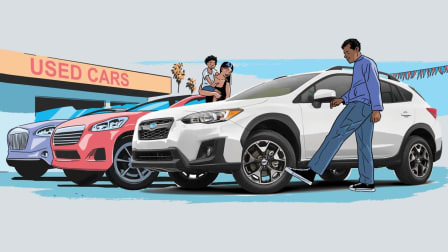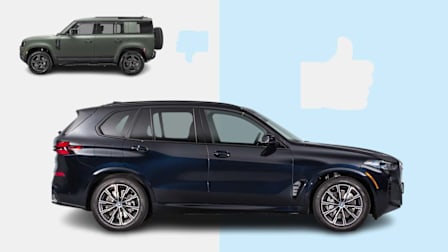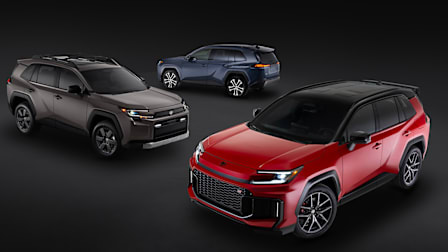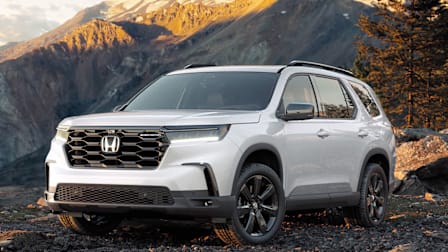Preview: 2027 BMW iX3 Has a New Platform, New Look, and a 400-Mile Range
BMW's latest small electric SUV is the first model riding on the Neue Klasse platform, which can add up to 175 miles of range in just 10 minutes
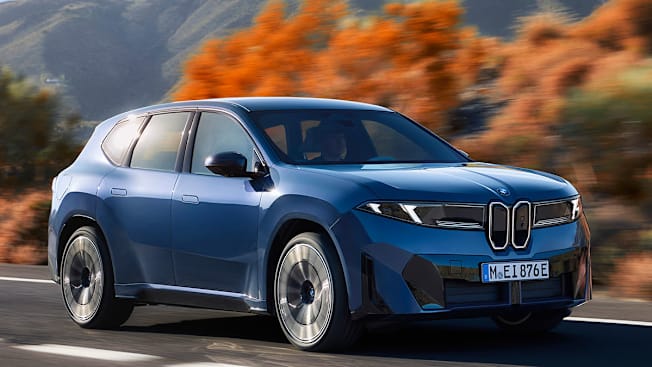
The 2027 BMW iX3 isn’t just an electric version of the X3 small SUV—it’s a new start for BMW. It rides on a new platform built especially for electric vehicles, and it features a fresh design language and a completely new operating system for the vehicle itself. On paper, it’s among the highest-range EVs on the road today, with up to 400 miles of range. It all runs on an 800-volt system capable of DC fast charging speeds up to 400 kilowatts, which BMW claims can add up to 175 miles of range in just 10 minutes of charging.
Only one trim will be offered when the iX3 goes on sale to U.S. customers in summer 2026: the iX3 50 xDrive, whose dual-motor, all-wheel-drive powertrain is good for 463 hp. A second version, the iX3 40 xDrive, goes on sale in early 2027 with a range slightly over 300 miles. A single-motor, rear-wheel-drive model and other, to-be-announced versions will go on sale at a later date.
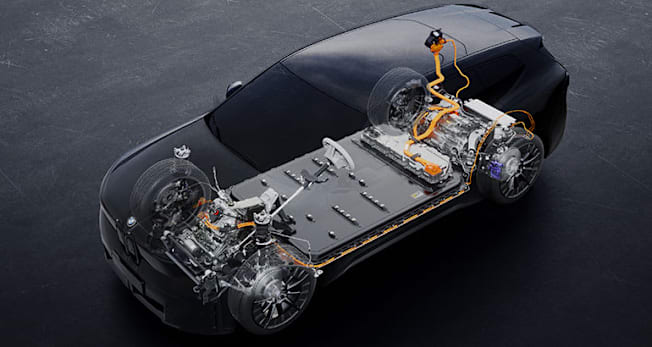
Photo: BMW Photo: BMW
CR's Take
New platform, new styling, new everything—who dis? The 400 miles of range and a peak charging rate of 400 kW in a practical SUV have our attention, and while this is a matter of preference, the iX3’s cleaner exterior design is refreshing to see. (Maybe BMW heard the critics of its recent designs after all?) Given that this new EV platform will underpin future BMWs, this makes us cautiously optimistic about new electric models to come.
There’s one phrase that BMW mentions repeatedly in its iX3 press release that gives us pause, however: “artificial intelligence.” The iX3’s extensive use of machine learning to detect user habits—including such things as when you’re most likely to open the charging flap—means that it will need to collect a lot of data on the people who use it. Not everyone is going to be comfortable with this kind of extensive data collection, particularly when those frequently visited locations can paint a pretty vivid picture of your usual daily schedule. Fortunately, BMW notes that these habit-learning features can be disabled, but that also means skipping out on some of the iX3’s defining features. (We’ll have to wait and see how well these features work in practice, and how well they’ll work with CR’s multiple testers—all of whom have different vehicular preferences.)
It’s a grim sign of the times when simple controls like stalks and buttons are comforting sights in a modern interior, but we’re not fans of the touch-sensitive control pads on the iX3’s steering wheel. Fellow German automaker Volkswagen is ditching them on its steering wheels for good reason: touch-sensitive pads are very easy to unintentionally engage when you brush them during routine steering maneuvers in some of their vehicles. The large central display gives us hope that onscreen functions should be easier to see at a glance, but just how large-print those features are is another thing we’ll have to keep an eye on in testing.
Outside
Perhaps the most noticeable thing about the BMW iX3 is what it doesn’t have. Unlike many modern BMWs (including the iX EV), the love-’em-or-hate-’em large dual kidney grilles have been replaced with a much smaller pair.
Instead, the grille is a throwback to the old “Neue Klasse” cars such as the BMW 2002, which featured smaller, narrower central kidneys and a set of four front headlamps. In lieu of a wide chrome grille surrounding the kidneys, the iX3 has horizontal lighting elements that emanate from the kidneys. (A lighted border around the kidneys is an optional upgrade.) Four angled headlights to the edge of the faux-grille mimic the placement of the four round headlamps on classic BMWs as well.
More restraint is the main theme here, with BMW’s new design language having fewer character lines, scoops, and the like. This isn’t to say the exterior is free of extra design flourishes, though: lines that add a more squared-off appearance to the wheel arches, blacked-out details on the lower portions of the front and rear bumpers, aggressive-looking front air intakes, a roof spoiler, and a bump-out in the rear for the taillights. The center of the iX3 is defined by a pair of creases that extend from the BMW roundel logo on the front to the center of the rear hatch. 20-inch alloy wheels come standard, with different 20-, 21-, and 22-inch designs available as upgrades.
Part of this newfound smoothness—which includes door handles that are flush with the surface of the door—is related to aerodynamics. The iX3 is also slightly narrower, lower, and has less ground clearance than the gas-powered X3, helping to minimize drag and increase efficiency. That wind-cheating slipperiness helps the iX3 achieve its long range, although we’ll have to see if those flush door handles make it harder to open in icy weather.
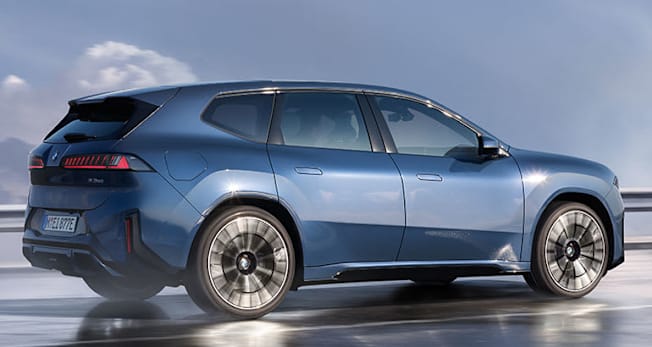
Photo: BMW Photo: BMW
Inside
As with the regular X3, the iX3 seats five passengers. The dashboard is dominated by a massive 17.9-inch, rhombus-shaped central infotainment touchscreen, which allows users to set certain functions as always available on the screen without having to dig through multiple menus to find them.
That isn’t the only screen of note in the iX3’s interior. Behind it is the long, horizontal display for BMW’s new Panoramic iDrive system, which includes both the standard driver’s information display, along with other information in a band that extends to the passenger side of the vehicle. This display is slightly different from the usual screens in a car, as it is a single black printed surface onto which information is projected, allowing for 3D effects. It sits closer than where a head-up display would typically appear, although BMW offers an optional head-up display that projects information onto the windshield in the driver’s immediate field of vision.
The new system allows occupants to customize which in-car apps or information (such as the voice assistant, weather, or stereo) shows across the upper band. Users can customize sounds and lights as well, and the effects are pretty special, with interior lights that can turn on when the driver reaches across the vehicle at night. It all runs on a new BMW Operating System X that debuts with the car, which can handle over-the-air updates as needed and download apps to use in the car, including games that are specifically designed for in-car use. The BMW can connect to a hotspot or WiFi signal, or it can use an optional unlimited data plan.
We’re disappointed that there are no physical controls for climate. Not all controls are touchscreen-based, as there are physical controls for the gear selector, front and rear defrosters, hazard warning lights, parking brake, windows, exterior mirrors, and stereo volume. Basic functions like windshield wipers and turn signals are on regular stalks.
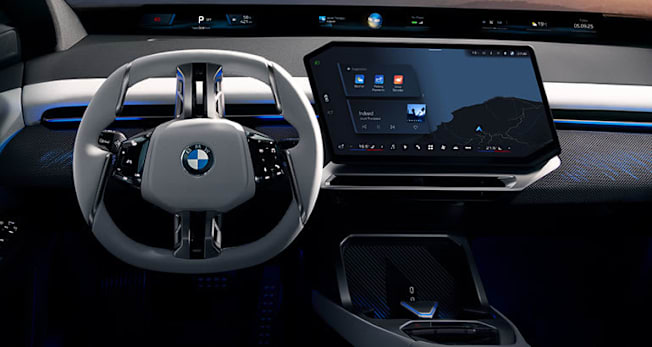
Photo: BMW Photo: BMW
Voice commands are also available to use via the iX3’s Intelligent Personal Assistant. BMW’s latest onboard voice assistant can even learn from user habits and make suggestions of features or actions to try. According to BMW, the assistant can even learn when certain actions are part of a standard routine, such as turning on heating and defrosting functions all at once in the winter, or blasting the seat ventilation and air conditioning to cool down the car in the summer. (If that’s all a bit too Robot Big Brother for your tastes or if you don’t trust that it will work properly, thankfully, BMW says that these habit-learning functions can be turned on and off.) The iX3 supports up to seven users in order to accommodate multiple personalization profiles.
The steering wheel also features touch-sensitive controls for driver assists, infotainment, and communications features, lighting up when controls are available to use on each touchpad. While these have haptic feedback that confirms when you’ve pressed one, we’ve found that touch-sensitive controls are frustratingly easy to engage by accident compared with regular buttons, especially on the steering wheel.
The interior is awash in unique design details, from the backlit textile dashboard to the rhombus-shaped screen. Standard features include dual-zone automatic climate control, a wireless charging pad, keyless entry, an alarm system, and wireless Android Auto and Apple CarPlay. Key options include a tinted panoramic moonroof with UV protection, three-zone automatic climate control, a 13-speaker Harmon Kardon stereo system, and a heated steering wheel.
The iX3 comes with an automatically opening tailgate. Cargo space behind the rear seats is 30.4 cubic feet, which can expand to 65 cubic feet with the rear seats down. There is also a modest front trunk (aka frunk) with 2 cubic feet of storage.
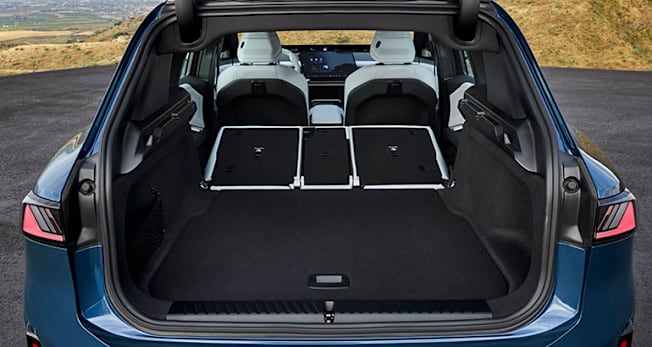
Photo: BMW Photo: BMW
What Drives It
If BMW can achieve its stated stats, the Neue Klasse-based iX3 should be one of the most advanced EVs on the market, with DC fast charging speeds of up to 400 kilowatts and up to 400 miles of range. The new model launches in iX3 50 xDrive trim, an all-wheel-drive version with two motors: one in the front and one in the rear. Combined, these motors output 463 hp and 476 lb.-ft. of torque. (A second iX3 40 xDrive model will be released shortly afterward, but technical data has not been released yet beyond an estimated range of just over 300 miles.)
The iX3 rides on a new 800-volt platform made specifically for EVs with BMW’s latest lithium-ion batteries, which are cylindrical cells that are more energy-dense and efficient than the ones BMW previously used in its EVs. The battery pack sits low in the vehicle as part of the structure of the vehicle itself, which keeps the center of gravity low and typically results in better handling. While battery capacity stats have yet to be released for the U.S. model, the German-market BMW site (where the iX3 is already on sale) lists a capacity of 108.7 kWh for the same battery. (Net battery capacities are calculated differently for different markets, however, so we expect that number to change for the U.S. spec sheet, but still land somewhere around the 100-kWh mark.)
That 400-kW peak charging rate enables the iX3 to go from a 10 to 80 percent state of charge in as little as 21 minutes at an 800-volt DC fast charging station, and can add approximately 175 miles of range in only 10 minutes. Its onboard charger also allows for a 19.2-kW max charging speed on an AC plug. (A BMW Wallbox Professional home-charging system will be released closer to the iX3’s on-sale date.)
The iX3 has a North American Charging Standard (NACS) port that is compatible with the Tesla Supercharger network, and it will include a Combined Charging System (CCS) adapter to use on the other most common style of fast-charging plug. The vehicle has plug-and-charge capabilities that enable users to simply plug the vehicle into compatible public chargers and have it bill automatically to a linked payment source.
BMW says its charging flap will use artificial intelligence to detect when to automatically open and close as it detects the intention to charge the vehicle. We’ll have to see how accurate these predictions really are when we test the vehicle, and for those who would rather not wait for the car to figure it out, you can still open the charge port door yourself.
The iX3 also recuperates some energy through its braking system; BMW says the system reclaims energy in 98 percent of braking maneuvers in regular driving conditions.
Another feature of the iX3 is bidirectional charging. Vehicle-to-load and vehicle-to-home capabilities let the iX3 power electrical devices, serve as backup power for a home in a blackout, and store energy generated by a home’s solar panels. It’s also set up for vehicle-to-grid, where the iX3 can feed energy back into the electrical grid, possibly saving cash on power bills when it’s plugged in at home. An adapter for both charging and discharging the battery on multiple types of plugs comes standard with the vehicle.
An optional tow hitch is available, with a rating up to 4,400 pounds, but as with all EVs, we expect that doing so will substantially lower its range.
A lower-cost, single-motor version will be available after launch.
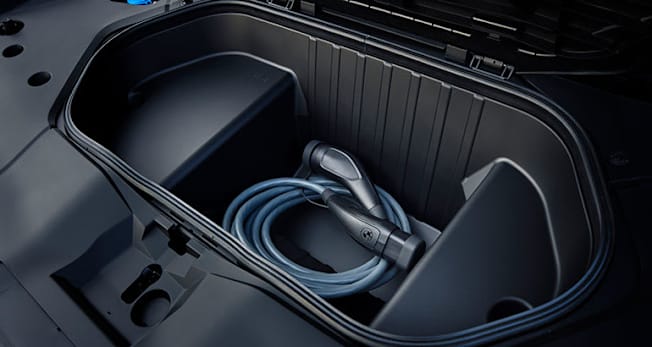
Photo: BMW Photo: BMW
Safety and Driver Assistance
Standard on the iX3 is BMW’s Active Driving Assistant Plus suite of safety features, which includes automatic emergency braking (AEB) with pedestrian detection, blind spot warning (BSW), lane keeping assistance (LKA), and exit warnings (which alert you to possible dangers as you leave the vehicle and can prevent you from dooring a cyclist). The suite also includes convenience features, including adaptive cruise control (ACC) and lane centering assistance.
Optional upgrades include a self-parking system that BMW claims can recognize, park, and drive out of both parallel and perpendicular parking spaces, and BMW’s Highway Assistant active driving assistance system. The automaker says that Highway Assistant can travel hands-free up to 85 mph on limited-access highways under driver supervision. The system can recommend lane changes when it approaches slower traffic, and BMW says the driver can accept that recommendation by glancing in the corresponding side mirror of that lane change, thanks to a driver monitoring sensor. Drivers can also make small steering and braking inputs without disengaging the Highway Assistant. That’s called “collaborative driving,” and we love to see it.
The iX3 even has safety features for use while parked. The optional Security Assistant will send a notification through the car’s connected My BMW App in the event of a theft attempt or door ding while parked, and the car’s cameras can record exterior footage of any collisions or attempted break-ins. Optional camera views can also let owners look inside and outside the iX3 on demand through the app.
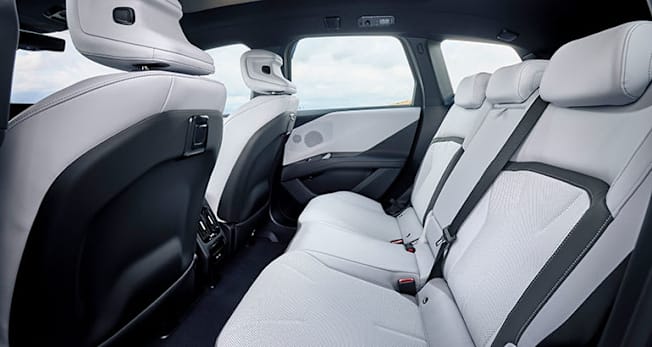
Photo: BMW Photo: BMW

















